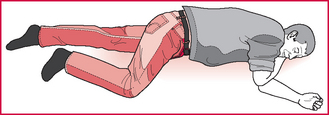R
radiography the use of electromagnetic radiation to create images of the body from which medical diagnoses can be made. Initially referred to ‘plain’ X-ray films but the general term has expanded to include other forms of diagnostic imaging such as ultrasound, CT and MRI scanning. Used in sports medicine to provide images of bone, soft tissue and internal organs to aid diagnosis and monitor the effects of treatment, e.g. the healing of a fracture or muscle tear. See also X-rays.
radiology the medical specialty covering the use and interpretation of X-ray images and, more recently, other imaging techniques.
radius the smaller of the two forearm bones. Articulates at the elbow with the humerus and at the wrist with the carpal bones. adj radial in descriptions of forearm structures, on or towards the side of the radius, i.e. the thumb side. See appendix 1.2 fig 1.
range of movement (ROM) how far a joint permits rotation of the moving parts about the axis of the joint. Usually measured in degrees or radians. Depends on the articulating surfaces, the length and elasticity of ligaments and the properties of muscle, tendon and other soft tissue surrounding the joint. Used as an index of flexibility and to assess progress in rehabilitation. For example, after repair of the anterior cruciate ligament, knee movement will be restricted and as rehabilitation progresses the ROM will increase back to normal. May be assessed by direct examination and measurement or using an isokinetic dynamometer.
rating of perceived exertion (RPE) a psychophysical measure of a person’s subjective experience of the intensity of exercise based on the totality of physical sensations the person experiences during physical activity, including sensations of a racing heart, breathlessness and muscle fatigue. Often used to train people to regulate the intensity of their exercise to achieve optimal results without the need for technical equipment.
reaction time the time that elapses between the presentation of a stimulus and a response; also known as response latency. choice reaction time reaction time when two or more stimuli are presented and different responses are required, also known as complex reaction time. discrimination reaction time reaction time where a response is required to only one of two or more stimuli. simple reaction time reaction time when only one stimulus is presented and one response is required.
reactive oxygen species (ROS) any oxygen-containing compound that is particularly reactive. From both exogenous and endogenous sources, ROS are present in all aerobic organisms, which have evolved defences against their potentially damaging effects and also ways of utilizing them (e.g. for signalling between and within cells and in the immune system, for killing invading micro-organisms). Some but not all ROS are free radicals (e.g. the superoxide anion (·O2−) and the hydroxyl radical (OH·) where an atom has one or more unpaired electrons in its outer orbital, making it particularly reactive. All the better known free radicals in the body are oxygen-based (although other atoms can also exist in this form) and are generated as by-products of oxidative metabolism. They are formed by exposure to ionizing radiation, cigarette smoke and other environmental pollutants and increased by excessive alcohol consumption and in infections. Free radicals are believed to cause cellular damage by lipid peroxidation which incorporates oxygen into membrane lipids. Protein and DNA damage are also involved. They are implicated in ageing and disease, including atherosclerosis (hence coronary heart disease and stroke), cancers and obstructive lung disease. Antioxidant enzymes protect cell membranes by reacting with the free radicals and removing them (e.g. removal of ·O2− by superoxide dismutase which produces hydrogen peroxide (H2O2), itself an ROS). In sport, ROS may be responsible for delayed-onset muscle soreness (DOMS). See also antioxidant enzymes, antioxidant nutrients, oxidative stress, lipids, vitamins.
receptor (1) in the nervous system, the distal ending of an afferent nerve, or specialist structure served by such a nerve, which signals the incidence of a mechanical, chemical, thermal or other stimulus (termed sensory receptor if the signal can reach consciousness); (2) in the context of cell signalling, a molecular structure on the surface of a cell (membrane receptor) or in its nucleus, to which hormonal or other signalling molecules or drugs must bind to initiate their effect. See also proprioceptor.
reciprocal inhibition inhibition of spinal cord motor neurons innervating muscles whose contraction would oppose an initiated movement, e.g. when flexing the elbow to lift a weight, the elbow extensors are relaxed. Term introduced in the 1890s by Charles Sherrington (British neurophysiologist and Nobel prize winner) and later known as Sherrington’s law.
recommended daily allowance (RDA) refers to standards for intake level of a particular nutrient for specific groups of people. In the UK it has offically been replaced by dietary reference values (DRV) and their subcategories, but is still widely quoted on packaging with reference to vitamin content. See also appendix 4.
recovery position urgent first aid position to protect the airway of an unconscious or semi-conscious person, whatever the cause (e.g. victims of drowning or poisoning) until further medical assistance arrives. This position prevents the tongue falling back in the mouth, obstructing the airway, or the possible aspiration of blood or vomit into the lungs. The casualty is laid on one side with the underneath leg straight while the other leg is fully flexed at the hip, with the knee bent and resting on the ground, altering the centre of gravity to prevent rolling onto the back. The head is supported by the arm, maintaining the desired position with the face tilted towards the ground. It is important not to move the casualty if a spinal injury is suspected, unless for resuscitation. Also known as coma position.
< div class='tao-gold-member'>








